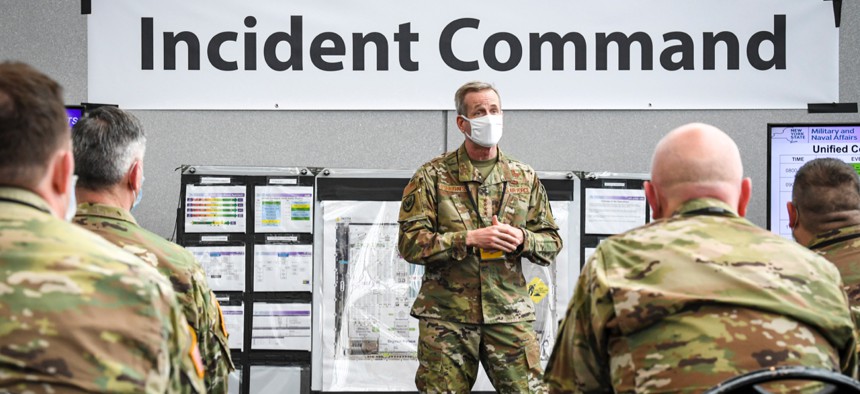
U.S. Air Force Gen. Terrence J. O’Shaughnessy, commander, U.S. Northern Command (NORTHCOM), speaks to military personnel during his visit to the Javits New York Medical Station. Mass Communication Specialist 1st Class Kleynia R. McKnight
The High-Tech Gear That’s Helping the US Military Decide Where to Send Medical Troops Next
An iPhone app and predictive analytics tell the four-star what’s going on right now.
The military doctors and nurses who deployed to New York City in April brought more than much-needed help to overwhelmed hospitals. They also brought a new iPhone app that gives their commanders a real-time look at the situation.
Now with hundreds of uniformed medical personnel spread out across the country, the app is helping senior officials decide where to send reinforcements. Moreover, the technology could serve as a precursor to how military leaders manage troops on the battlefield.
“I can track them real time and know exactly where they’re at,” said Gen. Terrence O’Shaughnessy, who as the commander of U.S. Northern Command is overseeing the military’s response to the coronavirus. “Twice a day they would...tell me how they’re doing both mentally and physically,” O’Shaughnessy said Monday during a Mitchell Institute event.
A four-star general having daily correspondence with forward-deployed troops is rare. But so is having service members deployed on their own or in small teams assigned to civilian hospitals around the country.
“I was concerned about: how are we going to control them? How are we going to keep in touch with them?” O’Shaughnessy said. “How are we going to make sure they have the right [personal protective equipment], and how are we going to make sure they’re doing all right.”
The technology — developed by Apple, Esri, and Monkton — has removed between five and 10 layers of bureaucracy that would have traditionally existed between the deployed medical professionals and O’Shaughnessy.
“That just went from five, six, 10 people between myself and the doctors [to] instantly understanding, sensing what was happening on the front lines at the battlefield,” he said.
As military doctors and nurses expanded deployments to other cities, the iPhones and apps have come with them as well.
Predictive analytics has informed O’Shaughnessy’s decisions about where healthcare professionals are needed most or a community that could benefit from field hospitals, like the ones that have been built in convention centers across the country. For instance, the general said the tech allowed him to make the decision about repositioning military assets from New York four to six days sooner than usual.
“Having that data available, having that predictive analysis and having that all brought up to the command level so we can make those decisions,” O’Shaughnessy said. “That’s exactly what we want to do on the homeland defense mission set and frankly that’s what we want to do as a Department of Defense as we employ the force all over the globe.”




